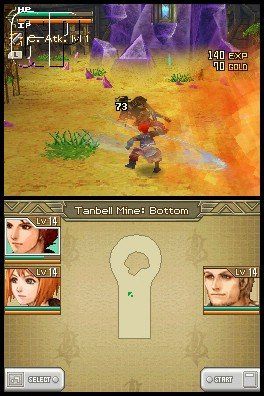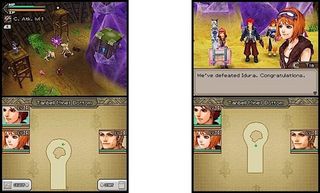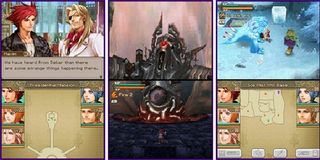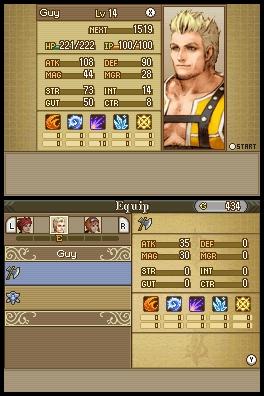GamesRadar+ Verdict
Pros
- +
Incredible accessibility for hardcore and rookies alike
- +
Beautiful and charming characters and environments
- +
Fun and challenging puzzles and minigames
Cons
- -
Severely limited inventory space
- -
Pedestrian story and themes
- -
Limited combat capabilities
Why you can trust GamesRadar+
Back in the day they built games that lasted. The standard 10 %26ndash; 20 hour fare of today%26rsquo;s %26lsquo;triple A%26rsquo; titles were Act 1 for games on the SNES. Lufia 2: Rise of the Sinistrals was exactly that sort of game, but it gets better: it%26rsquo;s been re-released for the DS. However, along with a slight name change, Lufia: Curse of the Sinistrals is not a straight remake like Chrono Trigger%26rsquo;s re-release on the DS. What%26rsquo;s changed, you ask? Lots.

But first, let%26rsquo;s talk about what this game is, shall we? Curse of the Sinistrals is an action/adventure RPG following the adventures of a young hero named Maxim. A great evil is about to befall the earth in the form of four %26lsquo;sinistrals%26rsquo; (similar to the four horsemen, but a bit more melancholy). And our hero is the only one who can stop them%26hellip; well%26hellip; not quite. He%26rsquo;ll have to recruit five other teammates fielding a variety of abilities to finish the job. Fans of the original probably already knew that, but what they might not have known is that the story has been changed slightly in some cases. While the over-arching plot is rarely affected, the various side-quests are tweaked to add a little more direction (and a little more charm) to the story.
The action itself does away with the classic turn-based combat of the original in favor of real-time hacking and slashing. While the player can only control one character on the screen at a time, he can switch between characters at will. When your sword arm gets tired, however, it also presents the player with dozens of devious puzzles and minigames. Most games would fall apart at the pace-shattering junctures; this is where LCotS shines the most. The puzzles are clever but never overly challenging, showcasing the unique talents of each of the game%26rsquo;s characters. Also the minigames make themselves integral to the game%26rsquo;s story rather than diverting it. One such minigame has the player manning the turret of a tank he%26rsquo;s just disabled, while another has the player jumping and ducking a mine cart in pursuit of two thieves. These segments are always brief and rarely repeated, making for fun changes of pace in between the action.

The game is also surprisingly forgiving. Saves and checkpoints are delivered generously. If the player messes up a puzzle, it can be reset. And if the party dies in battle, they can restart the last checkpoint with a permanent five-level increase to their stats with no penalty (which can be a godsend in certain insanely difficult boss battles). What%26rsquo;s to stop a player from dying over and over until they reach God-like power? Nothing. Nothing save your pride as a gamer. The feature is totally optional, however, so if you%26rsquo;re a glutton for punishment, you can send your puny weakling party right back into the fray as-is, if you prefer.
If you find yourself in need of an edge in battle, but would never stoop to pressing an %26lsquo;ease up%26rsquo; button (is it lonely up there on your pedestal?), LCotS also provides special stat-boosting items in the form of %26lsquo;Mystic Stones%26rsquo;. You%26rsquo;ll find these stones throughout your travels and can put them toward individual or party-based enhancements like increased HP or damage. While the implementation of the system is a bit of a pain, going into battle with the stones compared to without is basically the difference between going into battle equipped with either armor or a shirt.

LCotS%26rsquo; presentation is leaps and bounds better than the SNES original. The 3D overhaul presents the familiar towns of Lufia 2, like Elcid and Parcelyte, with a new sense of scale, grandeur, and beauty that just couldn%26rsquo;t come through on the SNES. Even on the DS, the monuments and palaces reserve a sense of awe and magnificence. And lest we forget, the hand-drawn character portraits make for much more expressive dialogue than the dead-pan soulless blocks that came before. One of the most charming aspects of LCotS%26rsquo; presentation, however, is that it never takes itself too seriously. It knows what it is, it knows its story is nothing special, and it points out plot holes, quirky user behavior, and JRPG tropes in self-reflexive parody - making itself just as fun to read as to play.
While LCotS is a whirlwind of fun and adventure, it is not without some flaws. The inventory system is a little too limiting. While it%26rsquo;s easy to collect all the items you will possibly need, the player is limited to 9 of each (which becomes a real pain in crucial moments in battle). While the combat system is refreshingly simple, it often devolves into %26lsquo;Attack-button%26rsquo; spamming affairs. It does offer multiple special attacks for each character, however these abilities need to be charged and time lost is blood lost. Also, being a 3D title, the camera will sometimes decide that the trees above you are far more interesting than the creatures gnawing your leg off. However, none of these issues were game breaking and were often mitigated by other design decisions.

Bottom line: If you%26rsquo;ve got a DS and $30 to spare, get Lufia: Curse of the Sinistrals. This is a charming, beautiful, and accessible title that dares to be different while paying homage to the original. It will make a fine addition to the collections of both its fans and action-RPG enthusiasts alike.
Oct 20, 2010
More info
| Genre | Role Playing |
| Description | If you’ve got a DS and $30 to spare, get Lufia: Curse of the Sinistrals. This is a charming, beautiful, and accessible title that dares to be different while paying homage to the original. It will make a fine addition to the collections of both its fans and action-RPG enthusiasts alike. |
| Platform | "DS" |
| US censor rating | "Everyone 10+" |
| UK censor rating | "" |
| Release date | 1 January 1970 (US), 1 January 1970 (UK) |

The game dev legend who programmed the first 3 Final Fantasy games says "I'd never seen any role-playing games until Final Fantasy"
Daredevil: Born Again will fix the showrunner's big issue with the Netflix series: "At its worst, it was two characters in a room talking about what a hero is"

In a huge win for niche games, this solo dev's 4-hour software adventure has racked up $1 million in revenue
Most Popular


